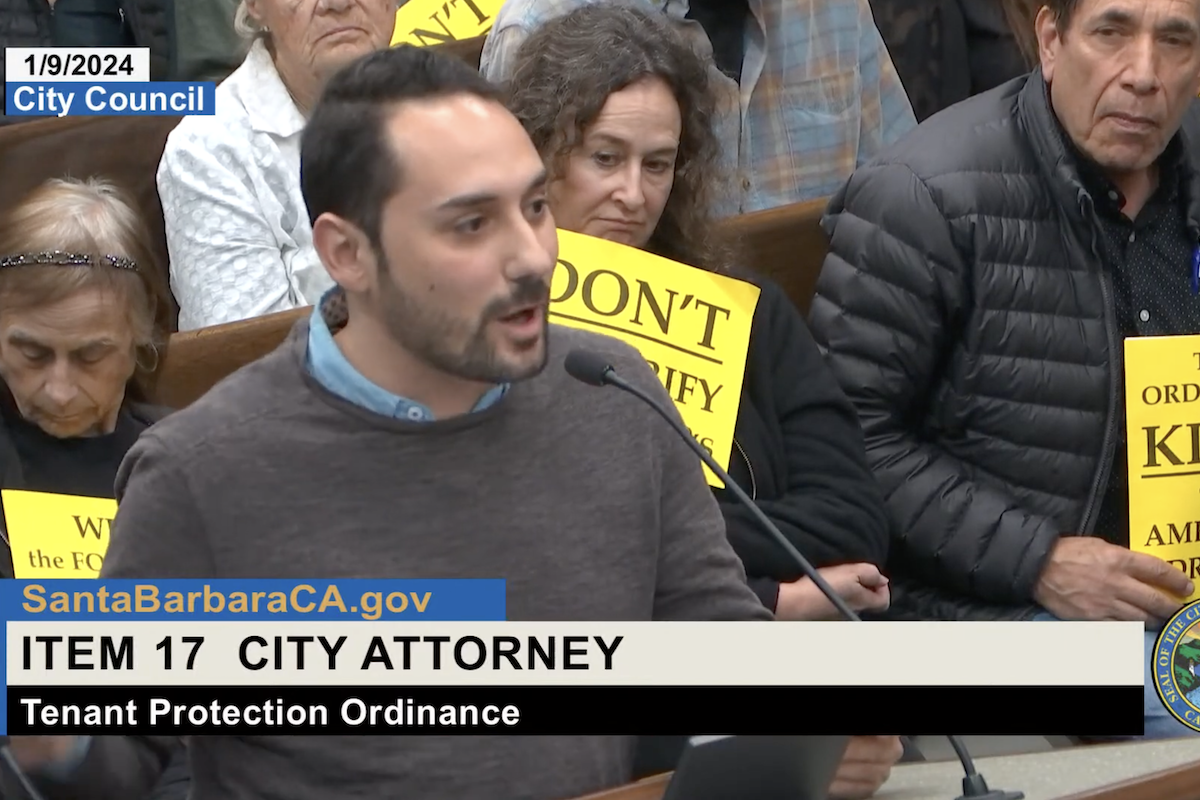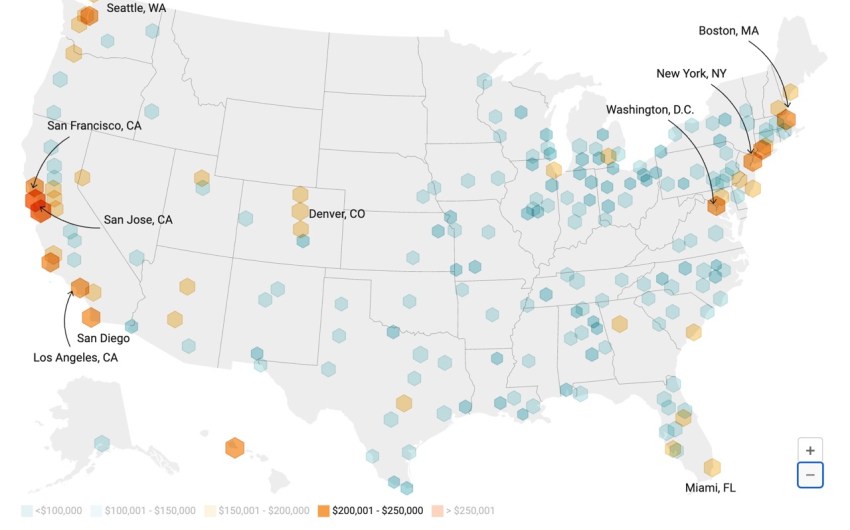Santa Barbara Council Passes Right to Re-Rent, but Kicks the Can on Capping Rent Increases
Landlords and Tenants Packed City Hall as City Council Discussed Stronger Tenant Protections

City Hall was packed on Tuesday as Santa Barbara City Council considered tenant protections designed to give city renters who had been displaced for renovations the right to re-rent a unit, as well as protect them from harassment. It was the latest showdown in the battle of landlords versus tenants, and both sides showed up by the dozens to plead with the council to understand the gravity of their situations.
Property owners — decked out in black to symbolize what one commenter said would be a “very black day” for landlords if the city passed the amendments — sat in the gallery with signs reading “Don’t Gentrify Mom & Pops” and “This Ordinance Kills the American Dream.”
Brian Johnson, president of the Santa Barbara Association of Realtors, warned that rental providers in the county were already worried about too many onerous regulations, and said that according to a recent survey of property owners in the region, “a majority say that it is very likely that they would consider leaving the rental business if current proposals became law.”
The mom-and-pop landlords, those who own only a handful of units, argued that the new regulations — which were intended as a way for the city to curb the alarming trend of mass evictions — would have unintended consequences on the existing housing market and could exacerbate the housing crisis.
On the other side of the coin, tenant advocates who helped ring the alarm on renovictions and helped city staff draft the protections over the past few months argued that the proposed changes were just adding to the city’s already existing eviction ordinance, and that delaying the protections further would come at the risk of more evictions.

Pat Wheatley, chair of the Housing Authority of the City of Santa Barbara’s Board of Commissioners, called the proposed amendments the “do-the-right-thing ordinance.” Stanley Tzankov, cofounder of the Santa Barbara Tenants Union, said that landlords operating in good faith should have no problems with the ordinance as proposed and asked that the council proceed with the changes as approved by the Ordinance Committee back in December.
“Please don’t kick this can down the road,” he said. “The very fabric and health of our region counts on you.”
Councilmember Mike Jordan — who helped carve out the protections during the Ordinance Committee meetings and even added a provision with a “cooling-off period” that would prohibit property owners who bought five or more units from evicting tenants for at least a year after purchase — said that his “intimate introduction” to the housing crisis came when he knocked on more than 50 doors at an apartment complex in his district at 215 Bath Street.
The 52-unit apartment complex was the center of a near-mass eviction last year when the Koto Group purchased the property for a reported $16.8 million and began issuing termination letters to the existing tenants for renovations. The new owners, some of whom spoke during the hearing, argued that the location was in disrepair and that the units had maintenance that could not be done without displacing tenants.
Before the Koto Group bought the 215 Bath Street complex in the fall of 2023, one longtime tenant told the Independent that a one-bedroom apartment was renting for $1,722 a month. Just two weeks ago, an online listing advertising a “chic urban lifestyle” at 215 Bath Street, read as follows: $1,550 for a shared room, $3,100 for a private room, or $6,200 for the entire one-bedroom apartment. The complex is now called the “West Beach College Commons.”
But while Councilmember Jordan showed support for the proposed changes during earlier discussions at the Ordinance Committee, on Tuesday he expressed doubts about some portions of the amendments, including the cap on how much landlords could raise the rent after giving tenants the right to return and his own suggestion of the “cooling-off period.”
Councilmember Alejandra Gutierrez also picked apart the ordinance and worried that it would adversely affect Latino landlords in District 1. Some, she said, threatened to sell their properties if the city passed the ordinance. She suggested the council table the idea to allow the city to get more public input before making a final decision.

Other councilmembers were determined to salvage the ordinance. Councilmember Kristen Sneddon offered a compromise: The council could pass the less controversial changes, such as the right to re-rent and language preventing harassment from landlords, while leaving out the cap on rent increases and the “cooling-off period.” This would give the tenants some level of protections immediately and allow the council to discuss at length whether to approve stronger provisions.
Councilmember Meagan Harmon, who supported the ordinance as written, expressed her frustration with the council hesitating on the rent cap, and specifically with Councilmember Jordan asking for “more data” before approving a rent cap number.
“I don’t understand what data you are asking for; I really don’t,” Harmon said. “A study or more data can’t give you or anybody else the answers you’re looking for when what you really want is a way out of making a difficult decision.”
After four hours of discussion, the council ultimately came to a 6-1 decision to approve a skeleton version of the tenant protections, with the right to re-rent after renovation (with no related cap on rent increase) and language prohibiting harassment by property owners. Councilmember Harmon opposed the motion, saying that she refused to vote on a “watered-down” version of the amendments.
Premier Events
Thu, May 02
5:00 PM
Santa Barbara
Things with Wings at Art & Soul
Sat, May 04
10:00 AM
Lompoc
RocketTown Comic Con 2024
Wed, May 01
7:30 PM
Santa Barbara
American Theatre Guild Presents “Come From Away”
Thu, May 02
5:00 PM
Santa Barbara
100th Birthday Tribute for James Galanos
Thu, May 02
5:00 PM
Santa Barbara
Meet the Creator of The Caregiver Oracle Deck
Fri, May 03
4:00 PM
Santa Barbara
Santa Barbara Fair+Expo “Double Thrill Double Fun”
Fri, May 03
8:00 PM
Santa barbara
Performance by Marca MP
Sat, May 04
10:00 AM
Solvang
Touch A Truck
Sat, May 04
11:00 AM
Santa Barbara
Mental Wellness Center’s 28th Annual Arts Faire
Sat, May 04
11:00 AM
Santa Barbara
Community History Day
Sat, May 04
3:00 PM
Solvang
The SYV Chorale Presents Disney Magic Concert
Sat, May 04
7:00 PM
Santa Barbara
A Star Wars Cantina Celebration: Renegades, Rebels, and Rogues
Thu, May 02 5:00 PM
Santa Barbara
Things with Wings at Art & Soul
Sat, May 04 10:00 AM
Lompoc
RocketTown Comic Con 2024
Wed, May 01 7:30 PM
Santa Barbara
American Theatre Guild Presents “Come From Away”
Thu, May 02 5:00 PM
Santa Barbara
100th Birthday Tribute for James Galanos
Thu, May 02 5:00 PM
Santa Barbara
Meet the Creator of The Caregiver Oracle Deck
Fri, May 03 4:00 PM
Santa Barbara
Santa Barbara Fair+Expo “Double Thrill Double Fun”
Fri, May 03 8:00 PM
Santa barbara
Performance by Marca MP
Sat, May 04 10:00 AM
Solvang
Touch A Truck
Sat, May 04 11:00 AM
Santa Barbara
Mental Wellness Center’s 28th Annual Arts Faire
Sat, May 04 11:00 AM
Santa Barbara
Community History Day
Sat, May 04 3:00 PM
Solvang
The SYV Chorale Presents Disney Magic Concert
Sat, May 04 7:00 PM
Santa Barbara

























You must be logged in to post a comment.